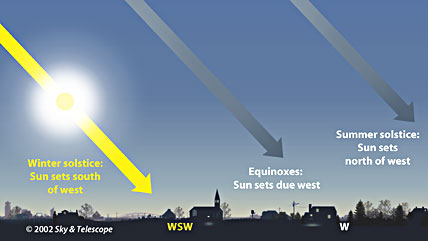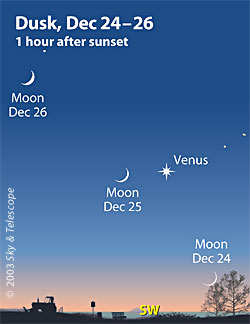December 16, 2003
Contact:
Alan MacRobert, Senior Editor
855-638-5388 x151, [email protected]
Note to Editors/Producers: This release is accompanied by a high-quality animation and two illustrations; see below.
On Monday morning, December 22nd, at 2:04 a.m. Eastern Standard Time, the Sun will reach its southernmost point in the sky for 2003 and begin its six-month return journey northward. This moment marks the December solstice, the official beginning of winter in the Northern Hemisphere and a time of great celebration in many northern cultures. (Note that in the western US the solstice occurs on Sunday night, December 21st, at 11:04 p.m. Pacific Standard Time.)
The seasons' starting times are governed by the Earth's motion around the Sun — or equivalently, from our point of view, the Sun's annual motion in Earth's sky. The start of winter (for the Northern Hemisphere) is defined as the moment when the Sun hovers over Earth's Tropic of Capricorn (the line of latitude 23½° south of the equator) before heading north — a moment called, by Northerners, the winter solstice.
The Sun appears to move north and south in our sky during the year because of what some might consider an awkward misalignment of our planet. Earth's axis is tilted with respect to our orbit around the Sun. So when we're on one side of our orbit, the Northern Hemisphere is tipped sunward and gets heated by more direct solar rays, making summer. When we're on the opposite side of our orbit, the Northern Hemisphere is tipped away from the Sun. The solar rays come in at a lower slant to this part of the world and heat the ground less, making winter.
North of the equator, the June and December solstices mark the beginning of summer and winter, respectively. The effect is opposite for inhabitants of the Southern Hemisphere; for them the December solstice signals the beginning of summer, while winter starts at the June solstice.
For a skywatcher on Earth (at north temperate latitudes), the effect is to make the Sun appear to move higher in the midday sky each day from December to June, and back down again from June to December. A solstice comes when the Sun is at the upper or lower end of its journey; an equinox comes when the Sun is halfway through each journey.
The word solstice comes from the Latin solstitium — sol meaning "sun" and -stitium "stoppage." The winter solstice marks the shortest day and longest night of the year. It is also the time when the days begin to grow longer and the nights shorter. In ancient cultures, the winter solstice was an auspicious moment. It meant the end of declining hours of sunlight and provided a sense of renewal as the Sun began its daily climb higher in the sky.
Winter-solstice celebrations could well be the world's oldest holidays. There are more known rituals associated with this solstice than for any other time of the year. Prior to the Christian era, Romans called this day Dies Natalis Invicti Solis, the Birthday of the Unconquered Sun. Earlier in Rome it was the time of Saturnalia, the Roman solstice holiday. In 46 BC the winter solstice fell around December 25th. Despite calendar reforms, these celebrations and the observance of Christmas by early Christians remained locked to the 25th.
Christmas Day 2003 brings a special astronomical treat. Two of the most beautiful sights in the sky will be visible side by side low in the southwest at dusk: Venus and a two-day old Moon. Catch them early before they set, and as the sky grows darker don't forget to look for the "old Moon in the new Moon's arms," where the Moon's entire face is visible — part of it as a brilliant thin crescent lit directly by the Sun, and the rest lit faintly by light reflected from the Earth. If you were standing on the Moon at this time, you would see a nearly-full Earth overhead, 50 times brighter than the full Moon as seen from Earth!
Sky & Telescope is making the following graphics available to the news media. Permission is granted for one-time, nonexclusive use in print and broadcast media, as long as appropriate credits (as noted in each caption) are included. Web publication must include a link to SkyandTelescope.com.

As seen from the Earth, during the course of a year the Sun migrates from north to south and back again. The Sun is farthest north at the June solstice, farthest south at the December solstice, and crosses the celestial equator at the equinoxes in March and September. These frames are from a 6.7-megabyte QuickTime animation suitable for television broadcast and available for downloading by FTP.
Sky & Telescope illustration.

The Sun rises due east and sets due west on the equinoxes in March and September. At other times of year it comes up and goes down somewhat to the north or south. The Sun rises due east and sets due west on the equinoxes in March and September. At other times of year it comes up and goes down somewhat to the north or south. Click on the image here to download a publication-quality version (121-kilobyte JPEG) by FTP.
Sky & Telescope illustration.

The waning crescent Moon points the way to Venus gleaming in the southwest at dusk on Christmas Day 2003. Click on the image above to download a publication-quality version (237-kilobyte JPEG) by anonymous FTP.
Sky & Telescope illustration by Steven Simpson.
 0
0
Comments
You must be logged in to post a comment.